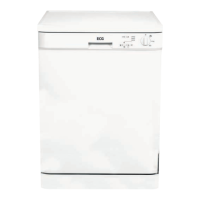What to do if the overflow alarm was activated on my ECG EDF 6023 WA?
- PPaul WellsSep 12, 2025
Switch off the dishwasher and close the water supply.

What to do if the overflow alarm was activated on my ECG EDF 6023 WA?
Switch off the dishwasher and close the water supply.
What to do if water remains in the ECG Dishwasher after the program ends?
If water remains in your ECG dishwasher after the program ends, the drain hose could be clogged or kinked, or the filters might be clogged. It's also possible that the program hasn't finished completely.
| Brand | ECG |
|---|---|
| Model | EDF 6023 WA Series |
| Category | Dishwasher |
| Language | English |
Basic precautions to prevent fire or electric shock during appliance use.
Guidelines for safe use by children aged 8+ and individuals with impairments.
Instructions for loading dishes, operating the door, and handling heating elements.
Information on power cable, grounding requirements, and proper electrical connections.
Explanation of the dishwasher's control panel, buttons, and indicators.
Identification and description of internal parts like baskets, spray arms, and filters.
Crucial safety warnings and precautions to be observed before installation.
Guidelines for selecting a suitable location and positioning the dishwasher.
Steps for connecting the water supply hose, including pressure and hose checks.
Instructions on connecting the drain hose and its maximum length restrictions.
Specifies the required height for connecting the drain hose to the sink siphon.
Steps for preparing the space under the worktop and removing the appliance's top plate.
Guidance on aligning the dishwasher using adjustable feet for stability.
Checks required for the electrical outlet before connecting the power cord.
Essential checks to perform before the first use of the dishwasher.
Instructions on setting up the water softener and refilling it with salt.
Guidance on filling the rinse aid and detergent dispensers correctly.
Procedure for testing the water hardness using the provided testing paper.
How to adjust the water softener settings based on test results.
Step-by-step guide to configure the water softener's hardness settings.
Advice on selecting and using dishwasher detergents properly.
Instructions on how to correctly fill the detergent dispenser compartments.
Considerations and recommendations for using 2-in-1 or 3-in-1 detergent tablets.
Explanation of the rinse aid's role in polishing dishes and improving drying.
How to fill and adjust the rinse aid dispenser to the correct level.
Best practices for loading dishes to ensure optimal cleaning results.
Instructions for arranging smaller, fragile items in the upper basket.
Guidance for loading larger, heavier items in the bottom basket.
Information on how to use the adjustable dish holders in the upper basket.
List of items that should not be washed in the dishwasher due to material or heat resistance.
Items that might be tarnished, lose color, or fade during washing.
Important notes regarding overloading and handling of sharp objects.
Factors contributing to damage of glassware and dishes during washing.
Recommended steps to prevent damage to dishes and glassware.
How to power on the dishwasher and select a wash program.
Using control panel indicators to monitor the washing and drying stages.
Procedure to modify or change a wash program while it is in progress.
Steps to abort a currently active wash program on the dishwasher.
Correct procedure for turning off the dishwasher after a cycle.
Advice on drying, door operation, and handling power failures post-program.
Best practices for safely unloading dishes after a wash cycle.
Overview of wash programs, their temperatures, and suitable soiling types.
Energy and water consumption figures for standard wash cycles with full load.
Energy and water consumption figures for wash cycles with half load.
Important notes and disclaimers regarding program consumption values.
Instructions for cleaning the dishwasher's exterior and control panel.
Guidance on cleaning the door seals and the interior surfaces of the dishwasher.
Step-by-step instructions for removing and cleaning the dishwasher's filters.
How to clean the spray arms to maintain optimal performance and prevent clogging.
Procedure for checking and cleaning the filter in the water inlet hose.
Maintenance procedures to follow after each wash cycle.
Instructions for preparing the appliance for extended periods of non-use.
Guidance on cleaning products and solvents that should not be used.
Tips for maintaining door seals and preventing unwanted odors.
Explanation of error codes displayed on the panel and their solutions.
Solutions for problems related to program initiation and indicator status.
Tips for common problems like poor washing results or detergent residue.
Addressing water overflow alarms and potential electronic card malfunctions.
Diagnosing and resolving issues related to rust stains and poor grounding.
Identifying causes for jolts and impacts heard during the wash cycle.
Key specifications including model number, EAN, and energy efficiency class.
Detailed figures for energy and water consumption per cycle and annually.
Specifications regarding physical dimensions, weight, power input, and voltage.
Explanations and disclaimers related to consumption and program data.
Guidelines for separating and recycling packaging materials and appliance components.
Proper procedures for recycling electric and electronic equipment at the end of its life.
Information on product compliance with EU directives and manual availability.
